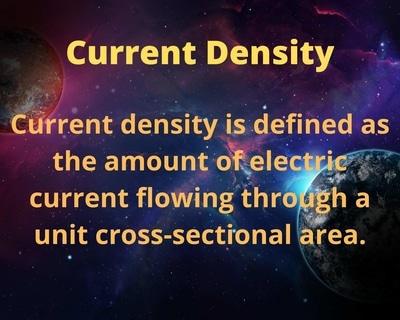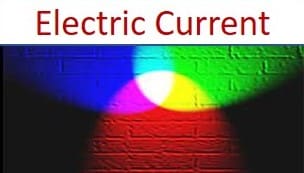Current density, also known as electric current density, is related to electromagnetism and is defined as the amount of electric current flowing through a unit cross-sectional area. It is a vector quantity. The SI unit for electric current density is ampere per square meter. Electric current density is denoted by “J.” The density of current is calculated by dividing the measured value of current intensity by the section area of wire through which current flows.

If a current I in a conductor is uniformly distributed over its area of crosssection (A), the ratio I/A is referred to as the current density at any point in the area. It is a vector quantity with the unit amp/m2.
Electric current is a scalar quantity that represents the flow of electrons through a conductor. Current density, on the other hand, is the flow of electrons through a conductor per unit cross-sectional area perpendicular to the flow of current. The magnitude of current density is also equivalent to the ratio of current (I) to the area (A).
Current density is critical in the design of electrical and electronic systems. The designed current level has a significant impact on circuit performance, and the current density is determined by the dimensions of the conducting elements.
Table of Contents
Current Density Formula
Current density is the measurement of electric current (charge flow in amperes) per unit area of cross-section (m2). This is a vector quantity with both a magnitude (scalar) and a direction.
J = I/A
- J = current density [amperes/m2]
- I = current through a conductor, in amperes
- A = cross-sectional area of the conductor, m2
Current density is a vector quantity. Its magnitude is equal to the ratio of current (I) to the area (A). The symbol for current density is J. (bold).
Frequently Asked Questions
1. Is current density a scalar or a vector quantity?
Current density is a vector quantity because it is defined as having a magnitude equal to the current flowing over a relatively tiny unit area, with the area normal to the direction of current flow and the direction parallel to the direction of current flow.
2. What is current density J?
Current density, also known as electric current density, is connected to electromagnetism and is defined as the quantity of electric current flowing through a unit cross-sectional area. It is a vector quantity.
3. Why current density is so important?
The design of electrical and electronic systems largely relies on current density. The designed current level has a significant influence on circuit performance, and the current density is determined by the size of the conducting parts.
4. What is meant by stress in physics?
Stress in physics is the force applied to a material, divided by the material’s cross-sectional area.
5. What is an electromagnet and how does it work?
Electromagnets are not the same as permanent magnets. Electromagnets are formed of wire coils that have electricity running through them. Moving charges generate magnetic fields, thus when an electric current flows through the coils of wire in an electromagnet, the coils behave like magnets.
6. What does photonics mean?
The physical science of light waves is known as photonics. It is concerned with the science of light generation, detection, and manipulation.
7. How does a hydro turbine work?
In a hydro turbine, water runs down a pipe, or penstock, and then pushes against and rotates blades in a turbine, spinning a generator to generate energy.
8. What is considered an alternative fuel vehicle?
A vehicle that operates on a fuel other than regular gasoline or diesel is referred to as an alternative fuel vehicle; any way of powering an engine that does not include petroleum is referred to as an alternative fuel vehicle.
9. What is Static pressure?
Static pressure is the pressure that exists when the fluid is not moving or while you are moving with the fluid. Furthermore, static pressure is applied uniformly to all sides of a duct system. This pressure is comparable to that obtained by inflating a balloon. The unit of measurement for static pressure in inches of the water column.
More Links
Magnetic Permeability
Surface Charge density
Electric Field of Sphere of Uniform Charge
Electromagnetic Force- An Overview
Electric Field Units & Definition
Alternating Current
- BCl3 Lewis Structure in four simple steps - November 1, 2023
- PH3 Lewis Structure in four simple steps - October 8, 2023
- PF3 Lewis structure in four simple steps - September 24, 2023



